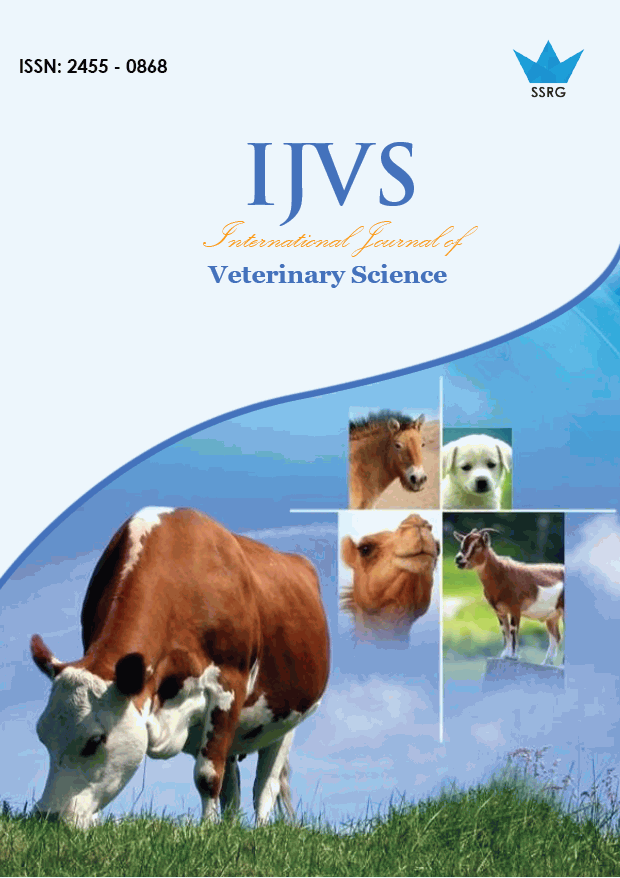Histoarchitectural Observation of the Vagina in Pre-laying and Laying Japanese Quail (Coturnix Coturnix Japonica)

| International Journal of Veterinary Science |
| © 2024 by SSRG - IJVS Journal |
| Volume 10 Issue 2 |
| Year of Publication : 2024 |
| Authors : P. N. Thakur, J. Y. Waghaye, C S Mamde, N. M. Karad, S. D. Kadam,C.D. kachave |
How to Cite?
P. N. Thakur, J. Y. Waghaye, C S Mamde, N. M. Karad, S. D. Kadam,C.D. kachave, "Histoarchitectural Observation of the Vagina in Pre-laying and Laying Japanese Quail (Coturnix Coturnix Japonica)," SSRG International Journal of Veterinary Science, vol. 10, no. 2, pp. 1-5, 2024. Crossref, https://doi.org/10.14445/24550868/IJVS-V10I2P101
Abstract:
The oviduct was observed histomorphologically in the current study at several age groups during the pre-laying and laying stages. (Age weeks 4 and 5 are prelaying, while weeks 6 and 7 are laying). The tunica mucosa, tunica muscularis, and tunica serosa are the three layers that make up the vaginal wall in birds of all ages, arranged histomorphologically from inside to exterior. Pre-laying birds’ vaginal tunica mucosa developed tall, narrow primary mucosal folds that were longitudinally oriented, along with a few minor secondary and tertiary folds. The vaginal mucosal folds in laying birds, however, were large and had tertiary folds. A thin layer of loose connective tissue was known as tunica serosa in all age groups.
Keywords:
Histomorphology, Histoarchitecture vagina, Quail pre-laying, Laying.
References:
[1] Hanaa Kareem Ali Aishammary, Ammar Ismail Jabar, and Rabab Abdul Ameer Nasser, “Geese Ovary and Oviduct from an Anatomical and Histological Point of View,” Research Journal of Pharmaceutical, Biological and Chemical Sciences, vol. 8, no. 6, pp. 207-219, 2017.
[Google Scholar]
[2] W.J.Jr. Bacha, and L.M. Bacha, Female Reproductive System, Color Atlas of Veterinary Histology, 2nd Edition, Lippincott Williams and Wilkins, Philadelphia, pp. 223-224, 2000. [3] M.R. Bakst, “Anatomical Basis of Sperm Storage in the Avian Oviduct,” Scanning Microscopy, vol. 1, no. 3, 1987.
[Google Scholar] [Publisher Link]
[4] Neelam Bansal et al., “Histomorphometrical and Histochemical Studies on the Oviduct of Punjab White Quails,” Indian Journal of Poultry Science, vol. 45, no. 1, pp. 88-92, 2010.
[Google Scholar] [Publisher Link]
[5] L.N. Das, and G. Biswal, “Microanatomy of Reproductive Tract of Domestic Duck,” Indian Veterinary Journal, vol. 45, no. 12, pp. 1003- 1009, 1968.
[Publisher Link]
[6] A. Deka et al., “Anatomical Studies on the Sperm Storage Organ of Pati and Chara-Chemballi Ducks,” Indian Journal of Animal Research, vol. 52, no. 4, pp. 543-546, 2018.
[CrossRef] [Google Scholar] [Publisher Link]
[7] R.A.B. Drury, and E.A. Wallington, Carleton’s Histological Technique, 5th Edition, Oxford University Press, New York, 1980.
[Publisher Link]
[8] M. El Gendy Essam et al., “Morphological and Histological Studies on the Female Oviduct of Balady Duck,” International Journal of Advanced Research in Biological Science, vol. 3, no. 7, pp. 171-180, 2016.
[Google Scholar]
[9] S. Fujji, “Scanning Electron Microscopic Observation on Ciliated Cells of the Chicken Oviduct in Various Functional Stage,” Journal of the Faculty of Applied Biological Science, vol. 20, no. 1, pp. 1-11, 1981.
[Google Scholar] [Publisher Link]
[10] P.M. Ghule et al., “Histomorphological Study of the Oviduct in Japanese Quail,” Indian Journal of Veterinary Anatomy, vol. 22, no. 1, pp. 40-42, 2010.
[Google Scholar] [Publisher Link]
[11] K.M. Lucy, and K.R. Harshan, “Distribution of Lymphoid Tissue in the Oviduct of Japanese Quail,” Journal of Indian Veterinary Association, vol. 9, no. 1, pp. 33-35, 2011.
[Google Scholar] [Publisher Link]
[12] Mahajan Tanvi et al., “A Scanning Electron Microscopy Study of the Female Reproductive Tract in White Leg Horn,” Indian Journal of Animal Research, vol. 57, no. 10, pp. 1385-1388, 2023.
[CrossRef] [Google Scholar] [Publisher Link]
[13] Shakir Mahmood Mirhish, and Riyadh Hameed Nsaif, “Histological Study of the Magnum and Vagina in Turkey Hens Meleagris Gallopavo,” Global Journal of Bio-Science and BioTechnology, vol. 2, no. 3, pp. 382 – 385, 2013.
[Google Scholar]
[14] R.C. Parizzi et al., “Macroscopic and Microscopic Anatomy of the Oviduct in the Sexually Mature Rhea,” Anatomia Histologia Embryologia, vol. 37, no. 3, pp. 169-176, 2008.
[CrossRef] [Google Scholar] [Publisher Link]
[15] Paria Parto et al., “The Microstructure of Oviduct in Laying Turkey Hen as Observed by Light and Scanning Electron Microscopes,” World Journal of Zoology, vol. 6, no. 2, pp. 120-125, 2011.
[Google Scholar]
[16] J. Priedkalns, and R. Leiser, Female Reproductive System: Dellmann’s Text Book of Veterinary Histology, Ed. J.A. Eurell and B.L. Frappier, 6th Ed., Blackwell Publishing Asia, pp. 226-278, 2006.
[Publisher Link]
[17] Ashraf Sobhy Mohamad Saber, S.A.M. Emara, and O.M.M. Abosaeda, “Light, Scanning and Transmission Electron Microscopical Study on the Oviduct of the Ostrich (Structhio Camelus),” Journal of Veterinary Anatomy, vol. 2, no. 2, pp. 79-89, 2009.
[CrossRef] [Google Scholar] [Publisher Link]
[18] Don. A. Samuelson, “Female Reproductive System” Textbook of Veterinary Histology, Saunders Elsevier, Missouri, pp. 478 – 484, 2006.
[Publisher Link]
[19] Meisji Liana Sari et al., “Characteristics Morphology Female Reproductive System Pegagan Ducks,” International Journal of Chemical Engineering and Applications, vol. 5, no. 4, pp. 307-310, 2014.
[Google Scholar] [Publisher Link]
[20] A. Sharaf, W. Eid, and A.A. Abul-Atta, “Age-Related Morphology of the Ostrich Oviduct (Isthumus, Uterus, and Vagina),” Bulgarian Journal of Veterinary Medicine, vol. 16, no. 3, pp. 145-158, 2013.
[Google Scholar]
[21] K. Vijaykumar, S. Paramasivan, and N. Madhu, “Histological and Histochemical Observations on Oviduct of Laying and Non-Laying Emu Birds,” International Journal of Academic Scientific Research, vol. 6, no. 4, pp. 89-96, 2016.
[Google Scholar]
[22] Henna Wani et al., “Histological and Histochemical Studies on the Reproductive Tract of Kashmir Faverolla Chicken,” Journal of Entomology and Zoology Studies, vol. 5, no. 6, pp. 2256-2262, 2017.
[Google Scholar]

 10.14445/24550868/IJVS-V10I2P101
10.14445/24550868/IJVS-V10I2P101